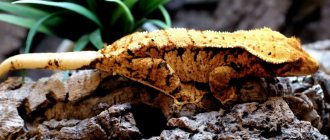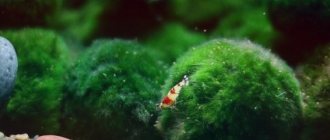Phelsumas are diurnal geckos. They live in Madagascar, Seychelles, Comoros and some other regions. They live mainly in trees.
Their peculiarity is bright skin, sometimes with contrasting splashes. The size of felsum ranges from 10 to 30 cm.
Maintenance and care
Best kept alone or in a pair. Two males cannot be kept together, otherwise the dominant male will beat the second until he injures or kills.
At times, even couples begin to fight, in which case they need to be seated for a while.
Apparently, it depends on the character and conditions, since other couples live calmly throughout their lives. Such couples cannot be split, as they may not accept another partner.
Keep felsum in a well-planted terrarium close to its natural environment. Since in nature they live in trees, the terrarium should be vertical.
Branches, driftwood and bamboo are necessary for decorating the terrarium and so that felsumas can climb on them, bask while sitting on them and generally feel at home.
It is also advisable to plant living plants; they will decorate the terrarium and help maintain moisture.
Don't forget that they stick well to vertical surfaces and can easily escape from the terrarium, so it should be closed.
General information
The genus Phelsum includes 42 species, which in turn are divided into 66 subspecies. But the existing taxonomy is constantly being revised, and, in addition, sometimes new representatives of the genus Felsuma are discovered. In the 90s alone, 8 new species of felsum were described. Due to limited habitats, these lizards are under threat due to human activities.
Most Phelsum species are found in Madagascar, Comoros, Mauritius, Reunion and the Seychelles. One species, Phelsuma andamanensis, lives on one of the Andaman Islands south of India, and a couple more species can be found directly on the African continent.
Phelsuma lineata
Most felsumas live in various types of forests and can be found on trees and other vegetation. Several species live in drier habitats. One species prefers to live on the ground. All Phelsuma species are whiter and less active during daylight hours, with the only exception being Phelsuma guentheri.
Appearance and dimensions of felsum
All types of felsum can be placed into 3 size groups: large (18-30 cm), medium-sized types (13-18 cm) and small felsum (10-13 cm). All representatives of the genus are quite brightly colored, except, perhaps, for the gray Phelsuma guentheri. Typically, these lizards are colored emerald; often on the body you can see multi-colored spots and stripes that help distinguish different types of felsum.
Phelsuma guenther, or Guenther's day gecko - the only dim Phelsuma
Lighting and heating
Another beauty of felsum is that they are diurnal lizards. They are active during the day and do not hide like other species.
To be kept, they need heating; the heating point should have a temperature of up to 35°C, and the rest of the terrarium 25-28°C.
At night the temperature can drop to 20°C. It is important that the terrarium has both a heating point and cooler places; by moving between them, felsuma will be able to regulate its body temperature.
As for lighting, being a diurnal lizard, felsuma needs bright light and additional UV rays. In nature, it has enough of the spectrum that the sun provides, however, in the terrarium it no longer exists.
With a lack of UV lighting, the body stops producing vitamin D3 and stops absorbing calcium.
This is easily replenished - with a special UV lamp for reptiles and feeding with vitamins and calcium.
Breeding felsum
Day geckos reach sexual maturity at the age of 8-10 months. However, it is better to create pairs of older individuals, about two years old.
Mating does not last long, from 5 to 15 minutes, so it is not easy to catch the felsum directly in the process. The male approaches the female with a “robot-like” gait, shaking his head and twitching his tongue. If the female accepts his invitation and remains in place, copulation occurs. During the mating process, the male grabs the female by the back of her head with his jaws so that small wounds remain on her. It is from these wounds that one can determine that mating has taken place. The injuries received by the female are not dangerous and go away on their own within a few weeks.
Phelsuma Klemmeri in the process of mating
Males are very aggressive during the mating period, so be especially vigilant if you have more than one pair of felsum in your terrarium.
Three to four weeks after mating, the female gecko lays a pair of eggs (rarely one). Depending on the type of lizard, the eggs are attached to the substrate or not attached. Females lay eggs in one of the hollow tubes, often the same one each time. The female lays eggs every month, excluding winter. A healthy and well-kept felsuma can produce up to 20 eggs per year.
If the female has glued the eggs to the substrate in a place that is inappropriate in your opinion, cover them with a plastic cup with holes. To maintain humidity, you can put wet cotton wool in the cup. At the same time, the glass will protect the offspring from their parents.
Egg incubation
Incubation of felsum eggs is quite simple, although it differs from hatching eggs of other geckos. The fact is that all felsums lay hard-shelled eggs, like birds. Because of this feature, the eggs need to be in a moist substrate, they must lie on a dry surface, but at the same time be in an environment with sufficient humidity (cover with a plastic cup with holes).
Birth of baby Phelsuma kochi
Phelsum eggs are quite resistant to changes in humidity and temperature, but it is better to try to create optimal conditions for incubation: humidity 60-80% and temperature about 28˚C. Under such conditions, incubation takes 35-90 days, depending on the species. As with many reptiles, the temperature at which the eggs are hatched affects the sex of the future felsuma. At a temperature of about 30˚C, males are mainly produced, and at 25˚C, females are produced. But this ratio does not work for all species. If you need both males and females, you can do this: incubate at 30˚C during the day, and lower the temperature to 24˚C at night. With this mode, there is a high chance of getting a 50/50 sex ratio (but most likely you will get a little more females).
Raising juveniles
Juvenile felsumas
Juvenile lizards hatch at a size of about 2-2.5 cm. Caring for them is generally similar to caring for adults, but with a few differences.
In most species of felsum, the juveniles are quite aggressive, so it is advisable to keep the offspring one by one. A terrarium measuring 15x15x25 cm is quite suitable for growing a small felzumka. The interior is without pretensions: one plant, a UV lamp, a substrate. It is advisable to spray the terrarium 2 times a day; small felsumas do not tolerate dryness very well.
A newly hatched day gecko measures about 2 cm.
Feed with fruit flies, young crickets, and, of course, fruit. You have to be careful with crickets. If the cricket is not eaten and grows large enough, it may eat the lizard. Give fruit every day for the first month, then three to four times a week. Typically, felsums reach maturity in 8-12 months.
Keeping in pairs and groups
Most types of felsum are best kept in pairs. Moreover, every effort must be made to never separate an established family. There is no guarantee that after separating a pair, Felsuma will want to create a new one with an unfamiliar individual. Even established couples can reconsider their relationship after a short separation. Some species (Phelsuma cepediana, Phelsuma guimbeaui and subspecies, Phelsuma klemmeri, Phelsuma borbonica and subspecies, Phelsuma ornata and Phelsuma V-nigra pasteuri) can be kept in groups of one male and several females.
Conclusion
Phelsuma madagascarensis - Madagascar day gecko
I would like to wish everyone who is involved in this interesting business success in keeping and breeding Phelsuma. I'm thinking of having them in my place in the near future. It should be remembered that Phelsuma guentheri, in accordance with the CITES convention, is classified as category B2, and Phelsuma guentheri is classified as category A1. This means that they are all reducing their numbers for one reason or another. The export of felsum from Madagascar is highly limited and strictly regulated. So let's grow felsum at home!
Feeding
Day geckos are very unpretentious in feeding; in nature they eat a variety of insects, fruits, small lizards, even small rodents, if possible.
This unpretentiousness makes feeding felsum a fairly simple task.
They are eating:
- crickets
- mealworms
- cockroaches
- Zofobas
- snails
- mice
They also eat a variety of vegetables and fruits and mixtures. Adults can be fed insects twice a week and fruit once a week. It is highly advisable to treat insects with reptile powders containing calcium and vitamins.
Maintaining Health
Felsums are quite unpretentious, and usually they have no health problems. Don't forget to give vitamin-mineral complexes every feeding. Do not overfeed, this can lead to liver problems. Maintain optimal humidity levels. Due to its low level, problems with shedding are inevitable. Watch the lighting. A decrease in vitamin D interferes with the absorption of calcium. Wash and clean the terrarium regularly. The proliferation of viruses and bacteria will lead to lung diseases.
Communication with Phelzuma
These lizards are quite nimble, so you shouldn’t pick them up again. Never hold a felsuma by the tail, as this will cause injury. Also, remember that they are excellent climbers on vertical surfaces. Don't forget to close the terrarium.
The Panteric pet store offers only healthy animals. Our consultants will help you with your choice, recommend a terrarium, food, and accessories. If you have any questions about maintenance and care, they will be happy to answer them. And during your vacation, you can leave your pet in our hotel under the supervision of specialists.
Description
The day gecko is a special species belonging to the genus Phelsum. He received this nickname due to his daily activity. In size, adult individuals reach a length of up to 30 centimeters.
The standard color is rich green or light green. A distinctive feature of this species is the presence of red stripes between the eyes and nostrils, as well as red markings on the head. In addition, the animal may have red-brown spots on its back. Males are larger in size compared to females.
Reproduction
Reproductive age in Madagascar felsumas begins at the age of 10-12 months. They usually mate in winter. It takes 4-6 weeks until the eggs are laid. More often there are two, sometimes one. Experts recommend removing the eggs from the terrarium and transferring them to a cage. A box with a substrate is placed in it, into which the eggs are placed. The top of the box is covered with a damp cloth, and then with a lid. The temperature in the cage should be 25-30 degrees Celsius, humidity – 70-90%. At a temperature of 28 degrees and above, young geckos will be born in 60-65 days, about 25 degrees - in 79 days. Sometimes, having hatched, they are in no hurry to leave the shell and remain in it for up to a day.
The young animals are transferred to a separate aquarium, where the appropriate temperature and humidity level are maintained. They are fed small crickets and fruit flies, fruits, not forgetting mineral supplements.
With good care, the lifespan of Madagascar green felsumas in captivity is about ten years.
Habitat
Representatives of this species live in the eastern part of the Madagascar coast. Their habitat is forests with high humidity and thickets of bushes. They build their shelters in the hollows of old trees, in the roots of bushes or in stone piles. As a rule, they prefer to stay in one area without changing their habitat.
Did you know? Gecko eyes do not have a movable eyelid. Dirt is removed from them using the tongue.






